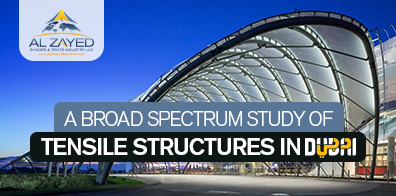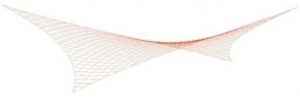
Dubai is considered one of the hottest regions on the face of the globe. When the summer arrives in full swing, the temperatures can soar well up to 55 degrees in the mid-day hours and people traveling require substantial shelter and protection from the hot Sun to stay fresh and arguably survive.
Tensile structures in Dubai are the most common sight when it comes to protection against the blistering summer sun. Since tensile structures in Dubai are economically feasible and are not too laborious to install, they have made their way to every commercial and residential building in the vicinity of UAE.
Tensile structures are flexible, sturdy structures that have been in use for quite some years now and are popular mainly because of their ability to withstand hefty loads. Tensile structures are by themselves light-weight, which makes them easier to install and use when it comes to creating architectural designs. All thanks to the technical advancements within the architectural structures industry that have fueled the popularity of tensile structure and rendered them a quintessential commodity for architectural designs across the globe.
History of Tensile structures
Tensile structures were developed by a Russian engineer named Vladimir Shukhov. With his innovative instruments, he calculated the stress and deformations of tensile structures, their shells, and membranes on an area of 27,000 sqm, and exhibited his findings in the Nizhny Novgorod Fair in 1896.
Much later in the 1950s, engineers and architects started taking interest in tensions to render load transfer easier and more cost-effective. In this era, two people became significant to tensile structures, namely Otto and Horst Berger who belonged to Germany and were responsible for the advancement of these structures. Later, Otto leveraged tensile structures in the construction of the West German Pavilion at the Expo ‘67 held in Montreal, and for the construction of the roof of the Olympic Stadium in the 1972 Summer Olympics held in Munich.
Some of the most prominent tensile structures in the world include the largest supported roof of the London Millennium Dome and the Hajj terminal in Jeddah. These two were designed in parts by Berger himself.
Design criteria for a tensile structure
Design holds utmost importance when it comes to the effectiveness of a tensile structure which is to be installed. A bad or inappropriate design that is created with false calculations will not result in a tensile structure performing optimally. There can be various constraints that need to be considered before installing a tensile structure, some of which are:
Types of tensile structures commonly used
There are two types of tensile structure shapes which have broadly categorized the whole structures:
Now, these shapes are created with the fabric for the entire structure to remain stable. Otto and Berger cam upon these shapes during their research on natural elements and forms. For these in particular, the soap bubbles became the initial inspiration.
Anticlastic shapes
An anticlastic shape of a tensile structure is created by having the radius of the principal curvature on the opposite sides of the fabric surface. As a result, when installed at a particular point, the fabric tension will increase at one curve, leaving the other one almost idle. Thereby, creating an environment of equilibrium and keeping the structure more stable.

Synclastic shapes
For a synclastic shape to retain its form, pressure should be created from within, thereby having the radius of the principal curvature on the same side of the anchored fabric. Synclastic shapes are mainly associated with air-inflated structures, and since the pumped air counteracts with myriad external forces, the structure keep its shape even in the most adverse weather conditions.

Commonly used Fabrics
The choice of fabric holds crucial importance when it comes to the appropriate functioning and durability of tensile structures. With different situations, the fabric is altered to maintain durability. Some factors that determine the kind of fabric to be used are:
Normally two kinds of fabrics are used:
Polyester Fabric
A woven polyester based cloth that has been coated with a PVC that can be an acrylic lacquer or an acrylic lacquer alloy coating in varying proportions.
Fiberglass fabric
Fiberglass fabric is normally used in areas where dirt creates problems. Fiberglass fabric can repel dust motes and dirt for years, and structures using this fabric are normally found clean when inspected after long periods. Normally such fabric is used in structures that are to be installed at spacious locations, such as stadiums.
Tensile structures are versatile and can be used for myriad purposes. One common use of small-scale tensile structures is car parking shades installed all over Dubai. Not only do they keep your vehicle cool in the hot summer days but also keep its paint glowing and shining for long. There are car parking shade manufacturing companies in Dubai that can help you in installing one at your house.